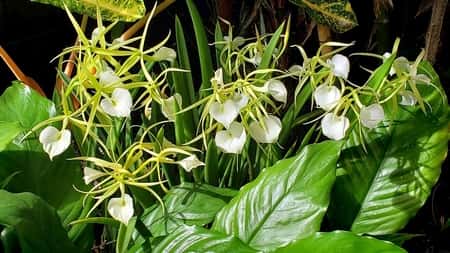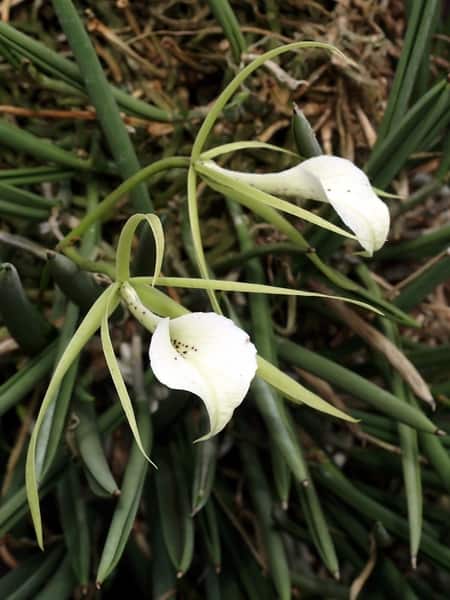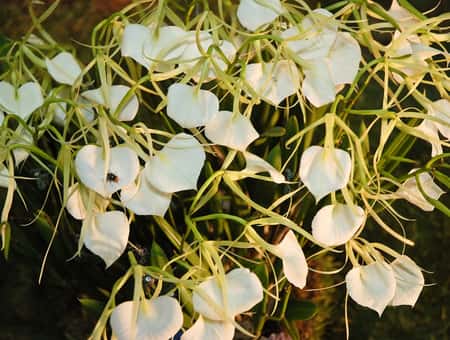Brassavola aren’t the topmost remembered orchids when it comes to naming orchid species and hybrids. With the right information, guides, and care, you can grow Brassavola orchids in your home in a south-facing window with lots of cool sun (if you live in the northern hemisphere). In this article that covers Brassavola Orchid Care, you’ll learn about how to best recreate the orchid’s environment and mimic the habitat that Brassavola orchids grow in. This way, they will flourish for you year after year, some with the most wonderful fragrances.
Brassavola Care & Culture Summary: Brassavola orchids need to be cultivated in high, bright light of 2500 to 3500 foot-candles, similar to Cattleya orchids. Humidity requirements for Brassavola orchids are extremely high, ranging from 60 to 80%. Brassavola orchids need to be watered frequently, yet require a distinct drying out period, growing best in intermediate temperatures of 77-78° F (25-26° C) during the day and nights averaging 66-67° F (17° C).
Brassavola nodosa

For some reason, even being beginner orchids, they’re a forgotten and overlooked genus. Yet, they are one of the easiest orchids to grow as a beginner, with hardy tendencies and aggressive growth patterns.
Once they have some time to mature, they’re practically indestructible. (Not to say that there isn’t an orchid I can’t kill, but that’s another topic…)
One of the most common traits (besides the star-shaped petals and sepals and other anatomical differences) is that all Brassavola are fragrant at night. These can include some of the most famous ones, such as Lady of the night (Brassavola nodosa) or some that the smell isn’t so appealing. If you are about to purchase a Brassavola, always inquire about the scent. Some can be overwhelming to have close by in a bedroom or home office.
Brassavola Orchids in Their Natural Habitat
Brassavola orchids are found in the western hemisphere, anywhere from southern Mexico, and heading south from there. They extended into the Gulf of Mexico, covering Colombia, Venezuela, Panama, Costa Rica, Brazil, Paraguay, Surinam, Guianas, and even in Jamaica. The Brassavola cucullate can be found in the west indies, but most all the other 27 species are found in the Americas.
Brassavola orchids are mostly lithophyte, attaching themselves to rocks, cliffs, and pebbles. These same orchids can also be epythitic, growing on the tree bark without harming the tree. They don’t tend to leave the coastal regions, and Brassavola orchids hardly ever are found above 1000 m (3300 ft). Low altitude is one of the customary trademarks of these orchids along with the star-shaped petals and sepals.
The most famous orchid in this genus is the Brassavola nodosa, which is found on coastal cliffs of Mexico, where the ocean is constantly providing high humidity and sporadic watering. The Brassavola venosa is one of the Brassavola species (along with the Brassavola cebolleta) that will sway from this generalization, being a drier orchid and preferring less watering. Both those are cliff-dwelling orchids.
Costa Rica is the second largest country where Brassavola orchids are found, where they grow in the moist forested foothills of the area. Yet humidity is always high year-round, so they don’t need to be right on the shoreline or near rivers or streams and can withstand longer periods without rain.
ALERT: Brassavola orchids are placed on an CITES Appendix II list, which means these orchids are not currently endangered. Unfortunately, if their unmonitored removal from natural habitats continues at the rate it currently has been, Brassavola orchids might become endangered in the near future.
Life Cycle of Brassavola Orchids: When Are They in Bloom?
Brassavola orchids are a smaller genus, only having 28 orchids in them. Each one has a specific and distinct blooming season according to their species. Instead of going through each one, I thought it would be better to make a graph.
Most Brassavola orchids will bloom only once in spring, summer, or fall, a few bloom twice, and rarely will one orchid bloom all year round. Not all the 28 are listed below, just the ones I could find information on. As time goes by, I’ll keep updating the graph below.
As for the blooms, they only smell at night because Brassavolas are pollinated by nocturnal moths. There is no reason to produce fragrance during midday hours, if the pollinating moth doesn’t fly by day.
This also explains the lack of color in the Brassavola orchids, since most are an alba, creamy-white color, at most tending to dabs of green. During the night, the most prevalent color seen is white, helping the moth find the blossoms during pitch-black nights.
If you’re looking for a big flower, go for the Brassavola grandiflora, which is the largest in the genus. The cucullata is bigger in size, but that is only due to the long tendrils that dangle down, forming the petals. The actual lip or labellum is smaller. Grandiflora are sometimes confused with nodosa, the famous lady of the night with heart-shaped lips, but the leaves on the Grandiflora will be rounder and fuller, compared with slender, tiny leaves on the nodosa.
| Brassavola Species | Flower Size | Month/Season in Bloom |
| Brassavola acaulis | 2 ¾ – 3¼ inches 7-8 cm | May-July |
| Brassavola cebolleta | 2 inches 5 cm | Late Spring, Summer, Fall. May and June |
| Brassavola cucullata | 7 inches 17 cm Due to long petals- not the lip | Summer to Fall |
| Brassavola duckeana | 3 inches 7.5 cm | from summer till autumn |
| Brassavola flagellaris | 2½ – 3 inches 6-7.5 cm | Spring to Summer |
| Brassavola nodosa | 3.5 inches 8 cm | Spring. Sometimes twice a year. |
| Brassavola perrinii | 2.5 to 5 inches 5 – 12 cm | Spring, Summer |
| Brassavola tuberculata | 2.5 inches to 3 inches 5 -7.5 cm | Late Spring, Early Summer |
| Brassavola venosa | 4.75 inches 11 cm | Spring. Sometimes 2x per year. |
Brassavola Light Requirements & Conditions for Growth
Brassavolas are light lovers. If you grow them indoors by windows, they’ll tolerate a south-facing window with no problem. They can even handle direct sunlight for a couple of hours, more so than a Phalaenopsis would. All Brassavola orchids do well in 2500-3500 fc (foot-candles) of light, which places them next to Vandas.
If you’re wondering what a foot-candle is, check out this article that explains light requirements and measurements. If you’re not much of a “science-techy” person, then download an app on your smartphone, and it will measure the foot-candles in your room.
All smartphones have cameras that measure lumens and that can be used to identify the brightness in your environment. Most apps for this are free, and I sure wouldn’t pay for it, since you can easily tell the light requirements with the simple tricks below.
To know if your orchid is getting enough light, look at the leaves. Since Brassavola have a slightly different green in the leaves, learn to “read” you orchid to find its normal pattern, and don’t stray from that.
For example, Brassavola acaulis, retusa, and flagerallis are naturally darker green.Brassavola martiana can range from this dark to a more olive-colored leaf. Brassavola cuculata have fleshy-green leaves. Brassavola fragrans are deeper, yellowish-green colored.
A few purple spots on the outer rims of the leaf and you’re orchid is in the maximum tolerance of sun that it can get. If the leaves start to turn a dark green like broccoli, they don’t have enough light. Either move them closer to the window or light but do it gradually.
No orchids do well with sudden change.
If you don’t provide enough light for Brassavolas, they won’t bloom. Keep them in the brightest light you can, but if the sun is pouring through the windows and the leaves are too hot, then move them. Sun isn’t the only requirement for sunburned leaves; heat can also burn them.
Brassavola Water Requirements
Brassavola orchids are not thirsty plants and can withstand drought seasons pretty well. Their leaves are designed to maintain and trap humidity, letting the least amount of perspiration through as possible. This is evident with the thin, needle-like leaves, compared to wider, thicker Cattleya leaves.
Not being too fussy about watering makes Brassavolas great beginner orchids. They’ll take a few days of watering too soon or forgetting to water them. Even though the pseudobulbs are not as visible as Cattleya pseudobulbs, Brassavolas actually have them.

They are almost mistaken with the leaves since they are so thin. In some species, the leaves are actually thicker than the leaves.
You might be wondering what pseudobulbs have to do with watering. The anatomical hint is that since Brassavolas have pseudobulbs, they can withstand periods of drying out better than monopodial orchids can. Yet since they are thin and tiny, they can’t go too long without water.
The best water regiment is to repeat what you do with Cattleyas, since they have the same preferences. A Phalaenopsis will like to be more wet compared to a Brassavola.
Since they live on rocks, cliffs, and in areas that get excessive airflow, they can’t stand to be soggy. This is the main reason they do well mounted. If you have a Brassavola in a hanging basket, add some sphagnum moss to the basket just to prevent the roots from going too dry in between waterings.
Almost all the recommendations for Brassavola potting media are mounts, whether they be tree bark, cork, ferns, or anything else, Brassavola grow better when their roots aren’t jammed into a pot. This way you can water them biweekly and still let them dry out by nighttime.
If you use some sphagnum moss in your mount, you can water them less. This will all depend on your environment, and my instructions here are for my home office, which is somewhat dry without my humidifier.
Tip: Brassavolas do have a dormancy period where they like to rest. Usually this will be for around 2 weeks, where you can drastically decrease the water. Since all Brassavolas live in high humidity climates, don’t cut all the water down, as you would a Catasetum orchid. In the case of Brassavolas, you can heavily mist the air around the potting medium during these two weeks to ensure their health.
In the mornings, the dew will fall heavily in these places where Brassavolas grow naturally. This is also a good source of morning water, so during their dormancy period, don’t completely dry them out.
Brassavola Humidity Preferences
Brassavola orchids don’t mind not having a lot of water, but they can’t stand low humidity. Research has indicated that Brassavolas will tolerate 40% humidity and still bloom, which make them a great beginner orchid. Yet…they grow considerably better in higher humidity. They forgive the mistakes that we keep submitting them to. If you can, raise the humidity to something they’d prefer more, around 50 to 70%.
Keep your humidifier running at around 60% and the Brassavola will thank you. If you don’t have a humidifier and are thinking about purchasing one, then check this article out that I wrote about humidifiers. It was the by-product of the research I did on humidifiers when I bought mine.
There I explain the main differences between several types of humidifiers and explain why I chose the model I did. If you don’t want to read all that, you can just check it out directly on Amazon to see the price here (Affiliate Link).
Heads Up: I have read some conflicting information about humidity when it comes to Brassavolas. I have a feeling that some ‘blogger-type” websites will find one specific species of Brassavola that prefers drier humidity, and place those lower (40% rH) as a common tendency for all Brassavolas. Other sites state that Brassavolas like 50 to 80%, and they thrive.
Not all Brassavola species are the same in terms of humidity and this may be their biggest variance. If in doubt, go for higher humidity.
Research your orchid species and check out books on the subject, since some websites are not as trustworthy as others. My go-to site for Brassavolas is this one , a site called Monaco Nature Encyclopedia. They have complete information in terms of Brassavolas
, a site called Monaco Nature Encyclopedia. They have complete information in terms of Brassavolas , has written articles on the nodosa, flagerallis, and cucullata, which are the main famous Brassavolas.
, has written articles on the nodosa, flagerallis, and cucullata, which are the main famous Brassavolas.
Since Brassavolas also grow in Brazil, and I lived there for many years, Brassavolas are not new orchids to me. I’m just learning to grow them indoors, now that I’m back home in Kansas (that epic saga took me three long, grueling years, which you can read about in my memoir on the About page). Indoor cultivating puts me in the “newbie” category, and Im relearning how to grow orchids but this time, inside. That is where this site was born, in how much research I had to do and am still doing.
Anyway… That’s the main reason I need a humidifier. In Brazil, I didn’t. It all depends on your growing conditions.
Brassavola Fertilization Rations
Brassavolas will follow similar patterns to most other orchids when it comes to fertilization. There is nothing different. You’ll need to use a blossom booster when you see a flower spike, but other than that, it’s mainly the same N-P-K in dilute amounts that you use on your other orchids, and always apply a flushing (or leaching) after the orchid has had a few weeks of fertilization.
Brassavolas don’t complain in terms of lack of fertilizer, but they will have a hard time if you over-fertilize. If you haven’t yet, be sure to check out the fertilization guide, below.
Can Brassavolas do well in Water Culture?
Honestly, I don’t know. I have never seen anyone suggest water culture for Brassavolas, so I just mount mine on driftwood. I have a strong hunch to think they wouldn’t thrive as well in water culture environment since these avid growers vigorously send roots out in all directions. This is a sign they prefer to climb and have something to hang on to. If you grow yours in water culture, I’d love to hear how that has gone and what tips you suggest.

Brassavola Potting Media and Proper Soil
If you are against mounting and don’t want to try a hanging basket, try a medium that drains fast and doesn’t retain much water. Bark, perlite, charcoal, river rocks, and lava rocks are a few suggestions. I wrote an article about several different types of potting media for orchids, and this other one where I talk about what not to pot in, like mulch.
Brassavolas like to be watered frequently, but need that dedicated time to dry out, much more than Phalaenopsis will. So definitely think about that when potting.
Brassavola Grooming and After-bloom Care
Don’t cut the old pseudobulb on Brassavolas. Unlike Cattleyas, which will not bloom again on older pseudobulb, Brassavolas will. It’s quite fun to see 2 spikes, an older and a newer one, emerging from the union of the leaf with the pseudobulb.
You can divide Brassavolas as long as they are enough live and healthy pseudobulbs to keep the plant thriving. I go for 5 pseudobulbs on each side, but that’s playing it safe. I’ve seen some repotting videos with a lot less. As long as they are healthy, the pseudobulbs will pop back up, since these orchids are vigorous growers, and aggressive in its propagations and spread.
Don’t Stop Learning!
If you want to be included in more information and get a 14-page fertilization guide, please sign up for my newsletter. I don’t spam, but send emails out bi-monthly with some curious topics of interest. If you want more information, click here to go to a specific page on this website where I explain it more in detail.

Also, if you are looking for an orchid journal to keep your notes specifically about orchid care, check out my 2 solutions for that on this page. If note-keeping isn’t your thing, then there is a free excel spreadsheet that you can download. Click here for more information on how to do that.
If you subscribe to my newsletter, I will send you a 14-page guide on the main tips of orchid fertilizer. It is downloadable and you can print it out on your computer. I designed the guide to double up as a coloring book, just to make it fun.
I wish you all the best with your Brassavola orchids. They make beautiful hanging pots and mounts and I strongly encourage you to go with that option, rather than in a pot.
Happy cultivating!


Thank you for your very instructive article. But I want to know a better way to eradicate the bugs on my orchids. My Brassavolas are very sensitive to some insects, I almost lost them because of it. Any better advise than water and soap or Neem oil ?
Hi Marta,
I suggest checking out another article that is more specific to bugs and insects. https://orchideria.com/orchid-bark-bugs/ And there is also an article on pesticides, that might be helpful. https://orchideria.com/best-insecticides/